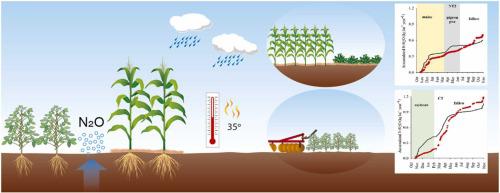Agriculture, Ecosystems & Environment ( IF 6.6 ) Pub Date : 2023-12-30 , DOI: 10.1016/j.agee.2023.108842 Fernando Antônio Macena da Silva , Alexsandra Duarte de Oliveira , Arminda Moreira de Carvalho , Robélio Leandro Marchão , Alfredo José Barreto Luiz , Fabiana Piontekowski Ribeiro , Artur Gustavo Müller

|
Soil-plant simulation models have been ever more used as predictive tools to evaluate productivity and environmental impacts of agriculture practices. The aims of this work were to evaluate the STICS model’s capacity of simulate the emissions of nitrous oxide (N2O) under different management systems. And, to predict, by applying the calibrated and validated STICS model, the N2O emissions, under different management systems, in the edaphoclimatic conditions of the Brazilian Cerrado. The study was conducted in a long-term experiment at Embrapa Cerrados, located in Planaltina/DF, Brazil. The experiment started in 1995. The following land use systems were evaluated: CT - conventional tillage with disc harrow, and biannual grass/legume rotation; NT1 - No-tillage, with biannual crop rotation – soybean/sorghum; NT2 - No-tillage, with biannual crop rotation – maize/pigeon pea.Closed static chambers and gas sample analysis by gas chromatography were used to measure N2O fluxes. The model was calibrated with the data measured in the CT and NT1 treatments. The attributes used in the calibration were: growth, development and yield of crops and N2O fluxes. To test the model, data from the NT2 treatment was used. Data for all treatments were collected at the same time. After calibration and validation, the STICS model was used to predict the effects of soil management systems, conventional (CT) and no-tillage (NT) on greenhouse gas emissions and on grain and biomass crops production. The simulation was made for the period from 2021 to 2070. The STICS model performed well at simulation of the following parameters: N2O emissions, soil water dynamics, soil temperature; and leaf area, aerial biomass and grain yield of soybean and maize. The performance of the model was good for the conventional soil management system as well as in the no-tillage system. Based on the predicted increase in temperature for the period 2021–2070, we can conclude from the data generated through the STICS model that there is strong evidence that grain yield and total aerial biomass of plants will decrease. The data show that there is a rising tendency in N2O emissions over the simulated period. This is expected to occur for the two soil management systems studied (NT and CT). We believe this increase in emissions along the years is related to temperature increase and to the reduction of crop cycle.
中文翻译:

农业管理和气候变化对巴西塞拉多地区 N2O 排放的影响:使用 STICS 土壤作物模型进行测量和模拟
土壤植物模拟模型越来越多地用作预测工具来评估农业实践的生产力和环境影响。本工作的目的是评估STICS模型模拟不同管理体系下一氧化二氮(N 2 O)排放的能力。并且,通过应用校准和验证的STICS模型,预测巴西塞拉多土壤气候条件下不同管理系统下的N 2 O排放量。该研究是在巴西 Planaltina/DF 的 Embrapa Cerrados 进行的一项长期实验中进行的。该实验于 1995 年开始。评估了以下土地利用系统: CT -使用圆盘耙进行常规耕作,以及一年两次的草/豆类轮作;NT1 - 免耕,一年两次轮作 - 大豆/高粱;NT2 - 免耕,一年两次轮作 - 玉米/木豆。使用密闭静态室和气相色谱法进行气体样品分析来测量 N 2 O 通量。该模型使用 CT 和 NT1 治疗中测量的数据进行校准。校准中使用的属性是:作物的生长、发育和产量以及N 2 O通量。为了测试该模型,使用了 NT2 处理的数据。同时收集所有治疗的数据。经过校准和验证后,STICS 模型用于预测土壤管理系统、常规(CT)和免耕(NT)对温室气体排放以及谷物和生物质作物生产的影响。模拟时间为2021年至2070年。STICS模型在以下参数的模拟中表现良好:N 2 O排放量、土壤水动态、土壤温度;以及大豆和玉米的叶面积、气生生物量和籽粒产量。该模型的性能对于传统土壤管理系统以及免耕系统都表现良好。根据对 2021 年至 2070 年期间气温上升的预测,我们可以从 STICS 模型生成的数据得出结论,有强有力的证据表明粮食产量和植物气生总生物量将会下降。数据显示,模拟期间N 2 O排放量呈上升趋势。所研究的两种土壤管理系统(NT 和 CT)预计会发生这种情况。我们认为,多年来排放量的增加与气温升高和作物周期缩短有关。



























 京公网安备 11010802027423号
京公网安备 11010802027423号